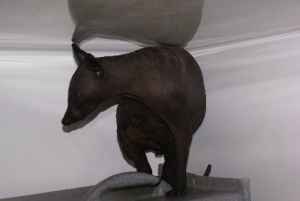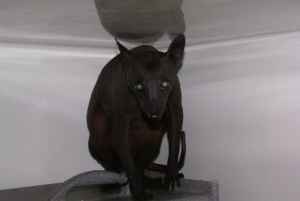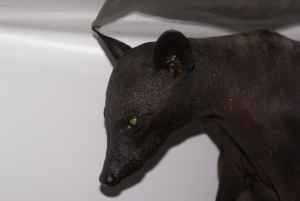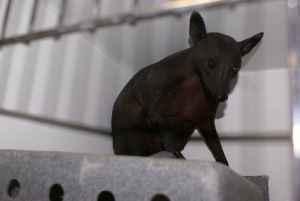Hairless Mystery Animal Photographed
Posted by: Loren Coleman on July 10th, 2009
The following animal jumped into the trunk of someone’s car in Goodhue, Minnesota, near Minneapolis, and was driven home (allegedly) before being photographed.
What do you think it is? The original picture-taker (an unnamed individual on Craigslist) said it was like a “hairless wallaby.” But it appears to be more like a hairless ????? Certainly, it is not a rex, a type of hairless cat, as some have claimed.
Thank goodness, at least, no one has labeled it with the Chupacabras moniker.
You be the cryptozoologist for the day; you come up with the positive identification. Your guesses, below, please.
Thanks to Jordan who heard about this Minnesota news but lives elsewhere, for the tip.
About Loren Coleman
Loren Coleman is one of the world’s leading cryptozoologists, some say “the” leading living cryptozoologist. Certainly, he is acknowledged as the current living American researcher and writer who has most popularized cryptozoology in the late 20th and early 21st centuries.
Starting his fieldwork and investigations in 1960, after traveling and trekking extensively in pursuit of cryptozoological mysteries, Coleman began writing to share his experiences in 1969. An honorary member of Ivan T. Sanderson’s Society for the Investigation of the Unexplained in the 1970s, Coleman has been bestowed with similar honorary memberships of the North Idaho College Cryptozoology Club in 1983, and in subsequent years, that of the British Columbia Scientific Cryptozoology Club, CryptoSafari International, and other international organizations. He was also a Life Member and Benefactor of the International Society of Cryptozoology (now-defunct).
Loren Coleman’s daily blog, as a member of the Cryptomundo Team, served as an ongoing avenue of communication for the ever-growing body of cryptozoo news from 2005 through 2013. He returned as an infrequent contributor beginning Halloween week of 2015.
Coleman is the founder in 2003, and current director of the International Cryptozoology Museum in Portland, Maine.














The writer may have thought it was a wallaby because he or she had seen one at a zoo or on television, and when this creature leaped, they immediately thought “kangaroo”. It probably never occurred to them to wonder what a completely hairless raccoon would look like if it suddenly leapt into their car.
I google imaged “hairless raccoon”. Check out the sixth image. I’d say that’s it.
I think the link Bluetinkerbell put up pretty much settles the speculation on this one. It appears from the report by wildlife officials who have actually captured the animal that this is indeed a hairless raccoon. The only mystery here now seems to be the actual circumstances surrounding its hairlessness, whether its mange or some toxic substance.
I’m not too surprised actually, the profile, ears, facial features, fingers, and body shape are all classic raccoon. That face and snout is very much in keeping with a raccoon’s facial structure, so I’m not sure why people have been dismissing that because it’s snout is “too thin.” The only thing that had given me pause about the raccoon possibility was that I have never seen one with this degree of complete hairlessness. But there really is nothing un-raccoon-like about it other than the lack of hair.
Anyway, like I said, considering the link Bluetinkerbell provided, it seems this case is pretty much closed.
Whatever it is it’s cool and weird looking. It looks like many things to me, part dog, part cat, part fox, heck it’s even kinda deer looking in one of the pics, though obviously it’s not.
looks to me like a “samson fox,” a red fox born without hair due to a genetic defect. it also kind of looks rodent like as well, odd.
I noticed something in pic 2. You can see a tail. That tail also matches the raccoon tail you see at the link mentioned above. Ergo my vote is bald raccoon.
I’m going with raccoon.
Here’s some additional photos from a myspace blog:
link
The close up of its face (3rd Pic) looks very fake.
Mystery man is quite correct about the dimensions and appearance for a hairless raccoon. The presence of fur gives the impression of a stockier bulkier animal – until you see one wet or with mange. Animals without their fur can stump a lot of folks because fur/hair is the identifier most humans use for mammals. As for the color of the eyes, that is simply normal eye shine for a raccoon. It shows up because of the shading.
I would have to agree it’s a bald racoon. Now the really question is why this genetic abnormality popping up more frequent thru out the USA?
Perfect example albanoism in muskrat’s is the first sign of in-breeding within the species. They look cute but when that starts happening the species declined to where they almost disappeared for three years before they started to make a come back.
It’s a coon. With sarcops. I don’t doubt over the course of my life that I have seen literally thousands of animals with sarcoptic mange, and that is what this is. If I could, I would take it and treat & rehab it, but I feel sure that a wildlife rehab specialist in that area will do that (provided the animal is healthy in other respects of course, with no sign of rabies). Sarcops is easy for young animals to “catch”, but it’s also easy to treat.
It’s mostly a disease of young animals, and canids, ursids and procyonids are especially vulnerable. (Cats can contract sarcoptic mange but it’s very rare). As the animal matures it becomes more immune to infestation by sarcoptic mites, and if you see a severe case of sarcops in an older animal, it’s almost always an animal that has been kept in unsanitary condition with poor nutrition. Fully adult wild animals almost never contract sarcoptic mange.
When you see a fox, raccoon, bear, coyote, or dog with an allover sarcoptic hair loss like this, it is almost always a young animal, less than a year old.
Some dog breeds are more apt to develop sarcoptic mange than others. Jack Russell terriers, pit bulls and other bulldog types, and coonhounds often develop mange as puppies. Since it’s caused by a highly contagious type of mite, keeping puppies isolated from other dogs can prevent them getting mange, but does that hinder their immune system from developing immunity to the mites? The jury is out on that.
I personally feel that a holistic approach, allowing puppies to interact naturally with other dogs (under controlled situations of course), and then treating the mites if they occur, is the best course. You wouldn’t want to let puppies play with dogs that are obviously mangy, but interaction with others of their kind is an important part of puppies’ socialization.
As they get older they rarely suffer from all-over infestation, but you will often see dogs, especially dogs that live or work in groups, with itchy spots caused by mange around their bellies and elbows.
Because it is too north to be El Chupacabra I’d say it is a dog or fox with mange.
It also has too small eyes that are green, and the American El Chupacabras do look like this but but the only place in America that sightings like this is Texas and this is Minnesota. So it is definetly is not El Chupacabra.
Agreed. Mapache encuerado (bald raccoon).
Good work, you guys 🙂
Grymhood,
You might be right. It looks somewhat like a piece of creative taxidermy, with those eyes.
~Isaiah
This is a dog that is called the American Hairless Terrier.
After seeing what raccoons look like hairless, next to the birdbath and birdfeeder I’m going to start leaving out a dish of Rogaine.
My vote definately goes to the hairless raccoon story. As everyone has been saying, the link that TinkerBell provided essentially puts the final stamp on the discussion. In addition I googled “hairless raccoon” and got to the Myspace blog photo of the creature’s face. I also agree with jerrywayne’s assumption that the area to the left of the eye in the third photograph is the watery tear duct; the coloration of the area in question looks like a beige color when examined more closely, inconsistent with the green of the iris as seen in all the other pictures. This would be even more consistent with a raccoon, as raccoons have very almond eyes with round pupils.
At any rate, this is one of the most sickly animals I have ever seen. I do hope the photographer did the responsible thing and had it taken care of professionally.
A fox with mange?
This is a Hairless Racoon that was found in Central Florida, and was brought to an animal shelter. The pictures you are all looking at are her in a cat cage at the shelter. It did not jump in a trunk of a car nor did this happen in Minnesota. We took these photos when she came in. If you would like to visit my myspace page and go to the Blog about The Hairless racoon you can all see a close up of her. (www.myspace.com/morganspiders) I do not know how these photos ended up with the story that you all have been told but I can tell you all that the story was not true. She was found in central Florida and was brought in to a shelter and the Department of Fish and Game came out and picked her up. She is living in a sanctuary. They did not release her back into the wild.
Hmmm…… I’d be interested to see a Sasquatch with mange, since common animals seem to be showing up hairless and scaring the Dickens out of people.
Fhqwhgads, it’s apparently been done already. See the figure on the left-hand side of the fourth photo down in this post:
https://cryptomundo.com//cryptozoo-news/andrewsarchus/
I think it is a fox with mange.
I’d agree with the Xolo (mexican hairless)
pic here. http://www.dog-breed-facts.com/images/Xolo/Mexican-Hairless-main.jpg
I think this raccoon illustrates an important difference between a hairless animal due to a genetic mutation, and an animal with hair loss due to a skin disease. I have treated many animals with sarcoptic mange (aka scabies), and none of them were completely bald, and most had other obvious lesions and were very itchy. This animal just does not look like a typical scabies presentation to me.
If these hairless raccoons are becoming more common, could they account for some of the Chupacabras reports? This one resembles a smaller version of the specimens featured in the recent MonsterQuest episode.
I received this message from Spider regarding the hairless raccoon this evening. It is not good:
“I inquired today as to the status of the raccoon. She was put in with all of the other raccoons. They were all raised by the people that worked at this place. Shorlty after the hairless was introduced they found her dead. They did send her off to be tested and they found out that she was positive for rabies. I am in shock to all of this. Considering these people exposed their resident raccoons to rabies. I don’t know what happened to their raccoons. I am so upset thinking that she was going to a place where people knew what they were doing. Raccoons are one of the biggest carriers of rabies. That is why we were not able to handle her (NO human contact). I have a great respect for wild life and it is a shame that not all people do. What a sad ending to something so unique and usual.”
“I am so sorry to have to pass on this bad news.”
Its a hairless racoon. Look at the long digits on the front paw and the bowed back. Picture the big tufts of hair around the face and you’ll see it.
I cant think of anything because it reminds me of so many things and ive read so munch on cryptids and studyed for years and i have never seen a specimen like this. my guess a hairless dog and i think it kind of looks like a bush baby and a mix of possum and hairless dog:)
It certainly wasn’t a wallaby, kangaroo or any other naked Australian marsupial. Ears, snout, setting of head on neck are all wrong.
There’s no doubt about what this creature is, yet questions still remain about it’s existence. Why is it that many varieties of animals are mutating to become hairless? While some hairless breeds of dog are ancient and many extinct, there are also several very new breeds. The American Hairless Terrier, for example, first occurred as a mutation in a litter of Rat Terriers sometime during the 60’s. The Chihuahua has only recently added new hairless members to it’s repertoire (many are hybrids, but there are a few that are the genuine article). The internet is littered with photos of recent sitings of strange hairless beasts. Why are these mutations occuring? Is there some signifigance to the locations in which these animals are found? What is in the water?
Honestly, discovering exactly what a creature is does little but raise more questions. How exactly did this racoon come to be hairless? Why has there been a spike in the sitings of hairless animals as of lately? The myth of El Chupacabras dates back farther than any photographic evidence, but who’s to say that a rare strain of rabies or mange isn’t responsible for the lore. Many of the “chupacabras” found recently have turned out to be nothing more than hairless Wolves, Foxes, & Coyotes. Perhaps there is a mysterious disease to blame, one that involves hairloss, sensitivity to light, and a desire to ingest blood (not unlike human vampirism, which is often attributed to Profiria).
Whatever the case may be, we should find ourselves asking more questions. Whether the cause of hairlessness is genetic, enviromental, or medical, it is definitely something that ought to be researched. However rare, it is irresponsible to assume that this is an isolated incident.
I wish I could see its hands and tail, I have 3 hairless possums i’ve raised, thats what it appears to be, with a pigment mutation.
dang this is a mystery. It does not seem like a raccoon. i’m only thinking people say it’s a raccoon cause of the mautak monster. other than that.. it’s unique as of now.
i think it’s a mysterious unknown animal, or at least a mysterious unknown hybrid of a known animal or a mysterious unknown hybrid of a known and unknown animal.
I have a picture of this animal!!!!! I was in fort lauderdale back in 1997 and there was a heard of racoons walking along the sidewalk and amongst the pack was that animal in the the picture above. I have pictures to prove it. It was the friendliest critter along with its racoon friends…